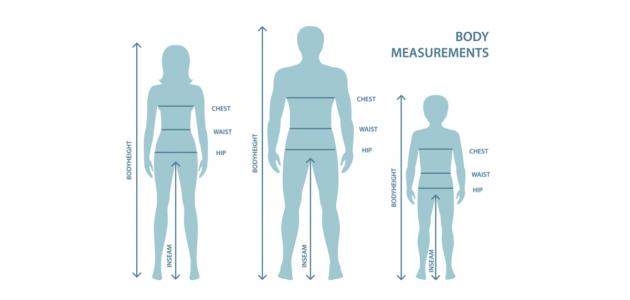Contents
Human height
Human height has increased steadily over the past two centuries in all parts of the world, due to the progress and development that included the fields of health and nutrition during this period; Studies have shown that a person's natural height is affected by two main factors: The genetic factor, and the environmental factor, where the genetic factor explains the differences in length between one race and another. And the length of human negative during childhood because may be affected by malnutrition or exposure to different diseases, and this is a proof that the human length and level of growth is linked to the standard of living, differing length in the region, it is affected by the economic situation in the region over time, and thus can be an indicator of The health of the individual, taking into account the influence of the genetic factor on him. [1]
Normal human height
Average height of males (1-18 years)
The following table shows the average normal height worldwide for males, depending on age: [2]
| Age (years) | Average length (cm) |
|---|---|
| Year | 76 cm |
| Two years | 88 cm |
| 3 years | 95 cm |
| 4 years | 103 cm |
| 5 years | 110 cm |
| 6 years | 116 cm |
| 7 years | 121 cm |
| 8 years | 127 cm |
| 9 years | 132 cm |
| 10 years | 137 cm |
| 11 years | 143 cm |
| 12 years | 150 cm |
| 13 years | 156 cm |
| 14 years | 163 cm |
| 15 years | 169 cm |
| 16 years | 173 cm |
| 17 years | 174 cm |
| 18 years | 177 cm |
Average height of females (1 - 18 years)
The following table shows the average normal height worldwide for females, depending on age: [2]
| Age (years) | Length (cm) |
|---|---|
| Year | 73 cm |
| Two years | 85 cm |
| 3 years | 95 cm |
| 4 years | 103 cm |
| 5 years | 108 cm |
| 6 years | 115 cm |
| 7 years | 120 cm |
| 8 years | 125 cm |
| 9 years | 130 cm |
| 10 years | 138 cm |
| 11 years | 143 cm |
| 12 years | 150 cm |
| 13 years | 155 cm |
| 14 years | 158 cm |
| 15 years | 158 cm |
| 16 years | 159 cm |
| 17 years | 160 cm |
Weight for height
Affects the length, sex, and the formation of muscle and fat, and the size of the skeleton in the ideal weight and natural persons, can know the ideal weight by the equation of the body mass index which is calculated by dividing weight ( in kilograms) on The square of height (in meters), which is as follows: (weight (kg) ÷ height 2 (meters)), and after calculating the BMI, the weight position is determined by comparing it with the following information: [3]
- Weight loss: less than 18.5 kg / m 2 .
- Healthy weight: between (18.5 and 24.9) kg / m 2 .
- Increase in weight: between (25.0 and 29.9) kg / m 2 .
- Obesity: more than 30.0 kg / m 2 .
Example: If the length is equal to 1.65 m, weight equal to 61 kg, we can mass index calculate the body by applying equation (61) / (1.65) 2 , to be the result of 22.4 kg / m 2 , and in this case, the weight is ideal and natural, because it falls within the range of normal weight is between (18.5 and 24.9) kg / m 2 .
Although BMI is considered one of the ways to know the status of weight, it depends on only two factors, namely weight and height, without counting the effect of age, skeletal size, muscle and fat composition, as athletes, for example, have large muscle mass and thus The equation will show an increase in weight. This is because the equation cannot differentiate between an increase in muscle mass due to exercise and an increase in fat mass. As the increase in muscle mass is good compared to the increase in fat mass, and the elderly tend to store large amounts of fat compared to younger adults, and the equation does not take age into account, [3] so the ideal weight can be determined by other measurements. , Of which: [4]
- Measuring the ratio of waist circumference to hip: where studies have shown that an increase in the proportion of fat accumulated around the waist are associated with a higher risk of problems of the heart and blood vessels.
- Measuring the amount of fat : the percentage of fat in the body, which shows the composition of the human body (muscle, fat), and thus it gives an indication of the risk of developing a group of diseases, but getting an accurate measurement of the amount of fat in the body is not easy.
The effect of nutrition on height in childhood
Unbalanced nutrition, eating large amounts of sugar, lack of activity and movement during childhood affect the proper growth of children, and affect height during adulthood, in addition, these factors may lead to an increase in obesity cases in childhood, so Limiting the amount of sugar, and eating a healthy and balanced diet are very important for growth at this stage. But if the child's growth rate is below normal, avoiding eating sugar alone will not solve the problem. As there is a set of other factors that affect growth and height, including food allergies, heart and kidney problems, thyroid problems, genetic influence, and sleep problems, so if there is a concern about the child's growth, you must speak with a specialist doctor to diagnose and treat the problem If any. [5]
References
- ↑ Max Roser, "Human Height" , www.ourworldindata.org , Retrieved 2017-12-28. Edited.
- ^ A b "In the Height the Measurement Children" , Www.fpnotebook.com , Retrieved 2017-12-28. Edited.
- ^ A b "What's the Average Weight for Women ?" , www.healthline.com , Retrieved 2017-12-28. Edited.
- ↑ Christian Nordqvist, "What is a Healthy Weight?" , Www.medicalnewstoday.com The , Retrieved 2017-12-28. Edited.
- ↑ HOLLY L. ROBERTS (2015-10-22), "Does Sugar Permanently Stunt Growth in Children?" , Www.livestrong.com , Retrieved 2018-1-20. Edited.










